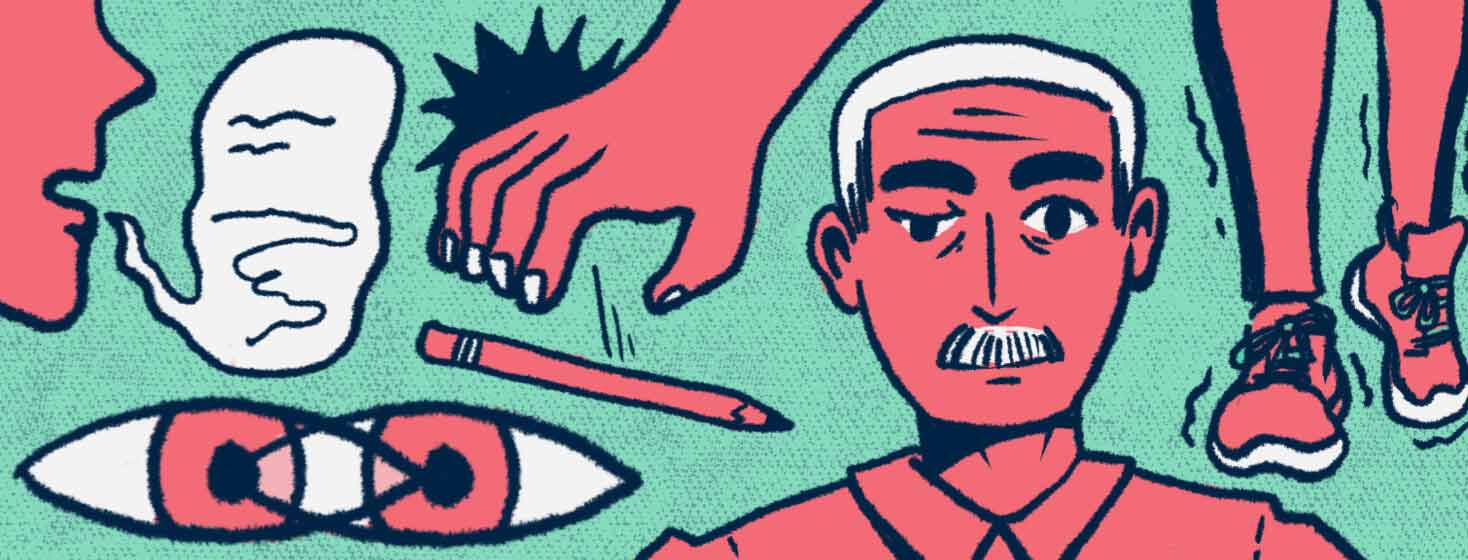What Is Myasthenia Gravis (MG)?
Reviewed by: HU Medical Review Board | Last reviewed: August 2020 | Last updated: October 2024
Myasthenia gravis (my-us-THEE-nee-uh GRA-vis) is a chronic autoimmune disease. Autoimmune means that the body’s immune system cannot tell the difference between healthy cells and invaders like viruses, fungi, or bacteria. Because it cannot tell the difference, the body begins to attack and damage healthy cells. Chronic means that it lasts for a long time or never goes away completely.
With myasthenia gravis (MG), the body attacks areas where nerves communicate with muscles. This communication is what makes muscles work. Without the ability to communicate properly, the muscles become weak and tire easily.1
MG is a rare condition, but once it is diagnosed the symptoms can usually be treated. Other, more common autoimmune conditions include lupus and rheumatoid arthritis.1
Did you know?
The term myasthenia gravis comes from Latin and Greek meaning “grave or serious muscle weakness.”
Symptoms
People with myasthenia gravis feel muscle weakness, especially when they are using those muscles. The weakness often gets worse at the end of the day or after exercise. After resting the muscles, the weakness gets better. The muscles most often affected are found in the:1-4
- Eyes and eyelids
- Face
- Mouth and throat
- Neck
- Wrists, fingers, and ankles
- Arms and legs
- Respiratory or upper body
When these muscles get weak, the most common results are:1-4
- Droopy eyelids
- Blurred or double vision
- Trouble smiling or keeping the eyes closed
- Slurred speech
- Trouble chewing or swallowing (especially liquids)
- Trouble holding the head up or the head drops forward
- Trouble picking up or holding things
- Tripping or unsteady walk
- Shortness of breath
Causes
When a person develops MG, their immune system begins to attack the way nerve cells “communicate” with the muscles they control. This area is called the neuromuscular junction. Normally, when a person decides to use a muscle, say to chew food, nerve cells release a chemical called acetylcholine. Acetylcholine locks on to a spot on the muscle called an acetylcholine receptor (AChR). This receptor communicates to the muscle, telling it to contract.1
In MG, the immune system blocks or destroys the acetylcholine receptors on the muscles. In some people with MG, the chemicals MuSK (Muscle-Specific Kinase) or LRP4 (low-density lipoprotein receptor-related protein 4) may not work properly.
Doctors also know that some people with MG also have a large or overactive thymus. This is a gland that plays a role in how the immune system works. However, it is not clear how this may cause MG.1,4
Diagnosis
It can be hard to diagnose MG because its symptoms can change and are not consistent. One person may have a droopy eyelid or double vision 1 minute and not the next. Someone else may have trouble swallowing or slur their words when talking for several minutes or hours. These symptoms may go away completely by the time they see their doctor. Also, the type of symptoms can, and often do, change.2
These changes in symptoms mean that people often go to the wrong doctor for help. Someone with vision problems will probably go to an optometrist or ophthalmologist. Someone with trouble swallowing may see an ear, nose, and throat doctor (otolaryngologist), while someone who feels short of breath may see a lung doctor (pulmonologist). However, a neurologist, a doctor who specializes in problems of the nervous system, is the best type of doctor to see for MG.2
This or That
Have you received a formal myasthenia gravis diagnosis?
Treatment
There is no cure for myasthenia gravis, but treatment can help control symptoms and calm the immune system. The most common treatments include:1
- Acetylcholinesterase inhibitors - Drugs that improve nerve signals to the muscles
- Steroids and other immunosuppressants - Drugs that calm an overactive immune system
- Plasmapheresis - A process where a machine removes abnormal antibodies in plasma (one of the building blocks of blood) and replaces it with “good” plasma
- Intravenous immunoglobulin (IVIG) - An intravenous injection (IV) of healthy antibodies
- Thymectomy - A surgery to remove the thymus gland
- Lifestyle and alternative treatments - Diet, exercise, rest, and stress reduction can all help manage MG symptoms
Myasthenic crisis
A myasthenic crisis is a serious complication of MG. During a crisis, the person with MG has so much trouble breathing that they may need a machine to help them breathe. This machine is called a ventilator.
A myasthenic crisis can be triggered by stress, infection, surgery, or reaction to a medicine. About 1 out of every 5 people with myasthenia gravis will have a myasthenic crisis at least one time in their life.1,3,4
Other things to note
People with myasthenia gravis are more likely to have other health conditions, such as:3,4
- Another autoimmune condition, especially those that involve the thyroid gland
- A tumor on their thymus gland (thymoma)
While there is no cure for MG, most people with the condition have a normal life expectancy. With treatment, some people can improve their muscle weakness and some even go into remission.1

